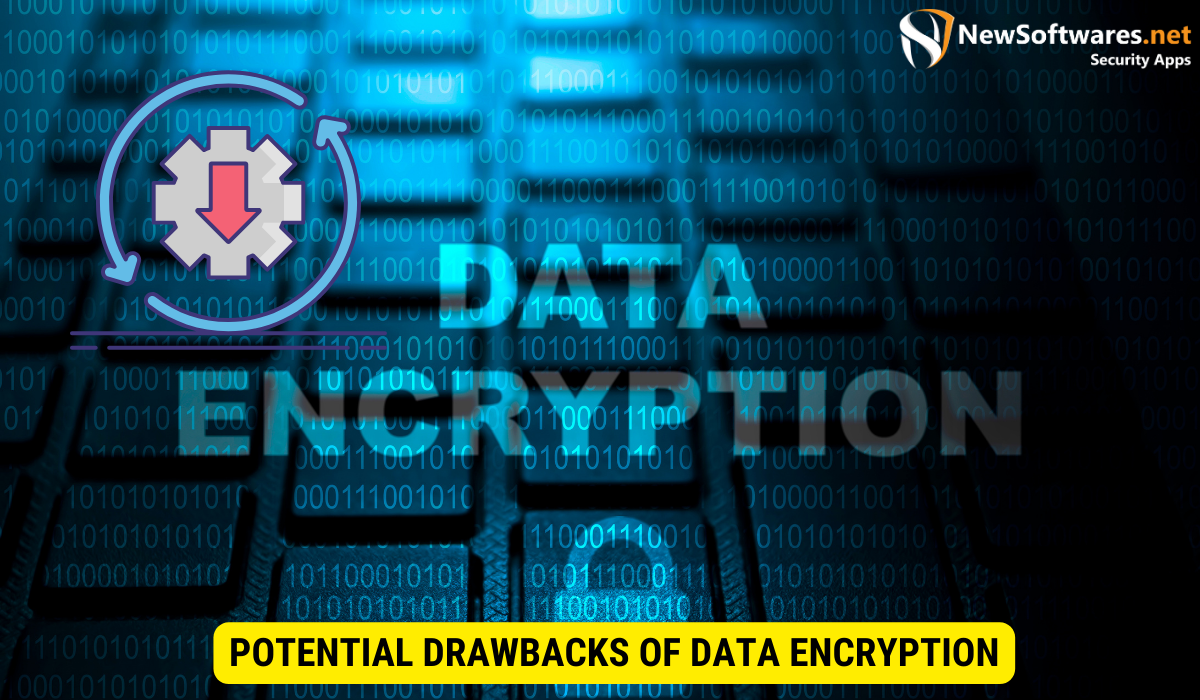Data encryption is the process of converting information into an unreadable code (ciphertext) to protect it from unauthorized access. It involves mathematical algorithms and encryption keys. Symmetric encryption uses a single key for both encryption and decryption, while asymmetric encryption uses a pair of keys (public and private). Encryption ensures data confidentiality, integrity, and compliance with regulations.
Data security has become a top priority for individuals and organizations in today’s digital age. Encrypting data is one of the most operative ways to protect sensitive data from unauthorized access and potential security breaches. Understanding the concept of data encryption, the process involved, and the benefits it offers is crucial for anyone concerned about safeguarding their confidential data.
Understanding the Concept of Data Encryption

Data encryption is a method of converting information into a code that cannot be easily read or understood by unauthorized individuals. This code, also known as ciphertext, is generated through a complex mathematical algorithm, making it difficult to decipher without the correct decryption key.
Defining Data Encryption
Data encryption, in simple terms, involves converting plain text into an encoded form. This encoding process adds a layer of security to the data, making it illegible to anyone without the specific decryption key.
When data is encrypted, it undergoes a series of transformations that scramble the information, rendering it unreadable. This process typically involves using cryptographic algorithms, which are planned to safeguard the confidentiality and integrity of the data. These algorithms use mathematical functions and keys to convert the original data into ciphertext, which is a jumble of characters and symbols.
One commonly used encryption algorithm is the Advanced Encryption Standard (AES). AES employs a symmetric key, meaning the same key is used for both encryption and decryption. This key is kept secret and is known only to the authorized parties involved in the communication or data storage.
Another popular encryption algorithm is the Rivest-Shamir-Adleman (RSA) algorithm, which is an asymmetric encryption method. RSA uses a pair of keys ,for instance, a public key for encoding and a remote key for decryption. The public key is freely available to anybody, whereas the owner keeps the private key as secret. This allows for safe communication between parties without sharing a common key.
The Importance of Data Encryption
The importance of data encryption cannot be overstated. It provides a secure means of transmitting sensitive information, such as financial data, personal details, and business secrets, over networks and storing them in databases. By encrypting data, individuals and organizations can significantly decrease the risk of data theft and protect their reputations.
Without encryption, data transmitted over networks or stored in databases is vulnerable to interception and unauthorized access. Hackers and cybercriminals are continuously seeking ways to exploit system vulnerabilities to gain access to valuable information. Encryption safeguards against such attacks by making the intercepted data useless without the decryption key.
Furthermore, data encryption is essential for compliance with various regulations and industry standards. Many sectors, including healthcare, finance, and government, have strict data protection requirements. Failure to fulfill with these regulations can result in severe penalties and reputational damage. By implementing robust encryption measures, organizations can demonstrate their commitment to data security and ensure compliance with legal and industry requirements.
In addition to protecting data during transmission and storage, encryption plays a crucial role in securing data at rest. This refers to data stored on physical devices, such as hard drives or solid-state drives. By encrypting the data on these devices, even if they are lost or stolen, the information remains inaccessible to unauthorized individuals.
It is worth noting that while encryption provides a high level of security, it is not foolproof. As technology advances, so do the techniques used by hackers to break encryption algorithms. Therefore, it is important to regularly update encryption methods and algorithms to stay ahead of potential threats.
The Process of Data Encryption
Data encryption involves a series of steps to convert plain text into ciphertext. Understanding how data encryption works and the different encryption methods available can help individuals make informed decisions regarding securing their data.
Data encryption is a fundamental aspect of modern cybersecurity. It plays a vital role in shielding sensitive information from unauthorized access and ensuring the confidentiality and integrity of data. Let’s delve deeper into the data encryption process and explore the various encryption methods used in practice.
How Data Encryption Works
At its core, data encryption relies on mathematical algorithms to scramble information into an unreadable format. This transformation ensures that even if an unauthorized person gains access to the encrypted data, they cannot decipher its contents without the corresponding decryption key.
The encryption process utilizes a key, which is a unique set of characters that serves as the codebook for encrypting and decrypting data. The key acts as a secret parameter, determining how the encryption algorithm manipulates the plain text to produce the ciphertext. Decrypting the ciphertext and recovering the original information without the correct key becomes extremely difficult, if not impossible.
One of the most widely used encryption techniques is the symmetric encryption method. In symmetric encryption, the similar key is used for encryption and decryption. This approach offers simplicity and efficiency, as the same key can lock and unlock the encrypted data. However, securely exchanging the key between the sender and recipient can be challenging.
On the other hand, asymmetric encryption, also known as public-key encryption, employs a pair of keys: a public key and a private key. The public key is used to encrypt the data, while the private key is used to decrypt it. This method eliminates the need for key exchange, as the public key can be simply distributed while the private key remains securely held by the intended recipient.
Different Types of Data Encryption
Several types of data encryption methods are available, each with its own strengths and weaknesses. The choice of encryption algorithm depends on factors such as the level of security required, the computational resources available, and the specific use case.
One commonly used encryption algorithm is the Advanced Encryption Standard. Advanced Encryption Standard (AES) is a symmetric encryption algorithm that has become the standard for securing sensitive data. It offers a high level of security and is widely adopted by governments, organizations, and individuals alike.
Another popular encryption algorithm is the Rivest Cipher (RC), which encompasses various versions such as RC2, RC4, and RC5. RC algorithms are known for their simplicity and speed, making them suitable for resource-constrained environments. However, some versions of RC have been found to have vulnerabilities, and therefore, their usage is often limited to specific scenarios.
The Data Encryption Standard (DES) is a widely used older symmetric encryption algorithm. Although more secure algorithms like AES have largely replaced DES, it still finds some applications in legacy systems. DES operates on 64-bit data blocks and uses a 56-bit key, making it relatively less secure than modern encryption standards.
Other notable encryption methods include the Triple Data Encryption Standard (3DES), which applies the DES algorithm multiple times to enhance security, and Elliptic Curve Cryptography (ECC), which leverages the mathematics of elliptic curves to provide strong encryption with shorter key lengths.
It is important to note that encryption alone is not sufficient to guarantee data security. Proper key management, secure storage of keys, and robust implementation of encryption algorithms are equally critical to ensure the effectiveness of data encryption.
In conclusion, data encryption is a vital component of cybersecurity, protecting sensitive information from unauthorized access. By understanding how data encryption works and the different encryption methods available, individuals can make informed decisions to safeguard their data and maintain the confidentiality and integrity of their digital assets.
The Role of Encryption Keys
Encryption keys play a vital role in data encryption. These keys lock and unlock the encrypted data, ensuring only official individuals can access the information.
Public and Private Keys
Public and private keys are commonly used in asymmetric encryption systems. The public key is freely available and can be used to encrypt data, while the private key, which should be kept secure, is required to decrypt the encrypted information.
Key Length and Encryption Strength
The length of the encryption key directly impacts the encryption strength. Longer keys are considered more secure because they offer more possible combinations, making it incredibly challenging for attackers to break the encryption.
Benefits of Encrypting Data
Encrypting data offers numerous benefits, particularly in protecting confidential information and ensuring compliance with data protection regulations.
Protecting Confidential Information
By encrypting data, individuals can safeguard their confidential information from unauthorized access. Even if a hacker manages to gain access to encrypted data, they cannot decipher it without the decryption key, rendering the stolen information useless.
Compliance with Data Protection Regulations
Data protection regulations, such as the General Data Protection Regulation (GDPR), require organizations to implement adequate security measures to protect customer data. Encrypting sensitive information is an essential step toward achieving compliance with these regulations.
Potential Drawbacks of Data Encryption

While data encryption offers significant benefits, there are a few potential drawbacks to consider. These include the complexity of the encryption process and the potential for lost or forgotten encryption keys.
Complexity and User-Friendliness
Implementing data encryption can be complex, requiring technical expertise and proper configuration. Encryption can sometimes hinder user-friendliness, as encrypted data may require additional steps to access and decrypt.
Potential for Lost or Forgotten Keys
If an encryption key is lost or forgotten, it can lead to irreversible data loss. It is crucial to keep the encryption keys in a secure location and have a backup strategy to prevent such scenarios.
Key Takeaways
- Data encryption converts information into unreadable ciphertext to protect it.
- Symmetric encryption uses one key for both encryption and decryption.
- Asymmetric encryption uses a pair of keys (public and private) for added security.
- Encryption keys play a crucial role in data protection.
- Encrypting data offers benefits like safeguarding sensitive information and complying with regulations.
- Potential drawbacks include complexity and the risk of losing encryption keys.
- Data encryption is fundamental for data security and maintaining a secure digital environment.
FAQs
What is data encryption, and why is it important?
Data encryption involves converting data into an unreadable format to protect it from unauthorized access. It is vital to safeguard sensitive information, maintain confidentiality, and comply with data protection regulations.
What are symmetric and asymmetric encryption?
Symmetric encryption uses the same key for both encryption and decryption, while asymmetric encryption uses a pair of keys: one for encryption (public) and one for decryption (private).
What role do encryption keys play in data encryption?
Encryption keys are essential for locking and unlocking encrypted data. Public keys are used for encryption, and private keys are needed for decryption.
What are the benefits of encrypting data?
Encrypting data protects confidential information from unauthorized access and helps organizations comply with data protection regulations like GDPR.
Are there potential drawbacks to data encryption?
Data encryption can be complex to implement and may require careful key management. Losing or forgetting encryption keys can lead to irreversible data loss.
Conclusion
In conclusion, understanding what data encryption does and its importance is fundamental for data security. Encrypting data provides a powerful shield against unauthorized access, protects confidential information, and aids in regulatory compliance. While data encryption might present some challenges, such as complexity and key management, the benefits significantly outweigh the potential drawbacks. Embracing data encryption is essential in safeguarding sensitive data and maintaining a secure digital environment.
